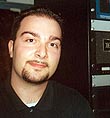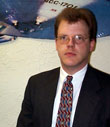|
|
 
|
|
Author
|
Topic: LFE settings in CP500
|
Antonio Marcheselli
Phenomenal Film Handler

Posts: 1260
From: Florence, Italy
Registered: Mar 2000
|
 posted 07-24-2000 03:45 PM
posted 07-24-2000 03:45 PM





Hello everyone!
I would like to understand what mean all settings in the Subwoofer channel in the CP500 eq.There are "frequency", "Cut" and "Q setting". Can someone explain me in simple words? Thanks, in advance! ------------------
Antonio Marcheselli
Projectionist of Cinema Vittoria
Florence, Italy
| IP: Logged
|
|
|
|
|
|
|
|
Aaron Sisemore
Flaming Ribs beat Reeses Peanut Butter Cups any day!

Posts: 3061
From: Rockwall TX USA
Registered: Sep 1999
|
 posted 07-24-2000 09:51 PM
posted 07-24-2000 09:51 PM




Its a simple parametric equalizer.Frequency: dials in the particular frequency that will be boosted or cut (to determine the exact frequency being equalized requires a spectrum analyzer) Cut: Once a desired frequency is selected via the 'frequency' control, the Cut control will raise or lower (boost or cut) the level of that frequency. Q: I am not absolutely certain but I believe the "Q" controls the resonance of that particular frequency or the resonance of the equalizer/filter (?)
Hope this is a little more simple and undertandable.
Aaron
| IP: Logged
|
|
|
|
|
|
|
|
|
|
Aaron Sisemore
Flaming Ribs beat Reeses Peanut Butter Cups any day!

Posts: 3061
From: Rockwall TX USA
Registered: Sep 1999
|
 posted 07-25-2000 01:33 PM
posted 07-25-2000 01:33 PM




Antonio Said:"Another question: How can I determine the "frequency" with a spectrum analyzer?" If you turn the Cut control for maximum boost, the frequency that the 'frequency' control is set for should spike up on the RTA display. If the sub is properly equalized the RTA display should be pretty much 'flat' across the low end of the spectrum with no peaks... Aaron
| IP: Logged
|
|
Antonio Marcheselli
Phenomenal Film Handler

Posts: 1260
From: Florence, Italy
Registered: Mar 2000
|
 posted 07-25-2000 03:12 PM
posted 07-25-2000 03:12 PM





Aaron,So to EQ a Subwoofer I should: 1. Set the "Cut" to maximum
2. Searching the frequency for what the RTA response is better and set it
3. Set "cut" and "Q" to a value that make the response as flat as possible Right? What happen if the same subwoofer in the same theater is set once to 60Hz and once to 33Hz? It works bettere around 60Hz first time and 33Hz the other? Or one of the setting is wrong since the "frequency" is a feature of the Subwoofer's type? Bye!
| IP: Logged
|
|
Aaron Sisemore
Flaming Ribs beat Reeses Peanut Butter Cups any day!

Posts: 3061
From: Rockwall TX USA
Registered: Sep 1999
|
 posted 07-25-2000 06:51 PM
posted 07-25-2000 06:51 PM




Antonio-Get a copy of the CP500 or CP65 installation and alignment manuals and follow the instructions to the letter using an RTA and microphone(s) in the auditorium. I am not exactly sure what you are meaning with the subwoofer being set for 33 and 60 Hz. Properly equalized, the sub should be fairly flat from close to DC to about 100 Hz. Aaron http://www.cinema-west.com
| IP: Logged
|
|
Steve Guttag
We forgot the crackers Gromit!!!

Posts: 12814
From: Annapolis, MD
Registered: Dec 1999
|
 posted 07-25-2000 07:03 PM
posted 07-25-2000 07:03 PM




Ok...here it goes...The CP-500's (as are all Dolby subwoofer eqs) is a single band parametric equalizer. Since their goal is to "kill" any resonant peaks caused by the subwoofer and room interaction, the "cut" means just that it is cut only. Therefore when set to max, the equalizer is set to flat, regardless of where the other two settings are (Q and frequency). How to set the eq: Look on your analyzer and see if you have any peeks in the pass band of your sub (different subs handle different ranges, particularly if B-6 tuned subs are used). If you don't have any pronounced peaks, then leave it alone (just like the stage channels, if they come up within spec, you don't adjust willy-nilly) How easy it is to adjust partially depends on your analyzer. I find most LED based analyzers have too slow ballistics to allow easy adjustment. My favorite analyzer is the Abacus ARTA-800, it is a scope attactment and the resulting display lets one see the affects of the parametric EQ very plainly and quickly. Anyway, what you want to do first is turn the "Q" to maximum. This will limit the bandwith of the equalizer. Then turn the "Cut" to minimum. This should put a finger down at the frequency selected. I start at the lowest frequency available and start raising the frequency until I see the "finger" move up until the "finger" is centered on the frequency where the peak was. This should make your analyzer display somthing that looks like two mountain tops with a valley where the center frequency of the eq is. Then start alternately turning back the "Q" and "CUT" controls until you get a smooth response. If the peak was broad, your "Q" will be low. If the peak only affected a couple of bands, the "Q" will be higher. Like all tuning related items, experience is the key. Futhermore, we all have our own styles for what sounds best and conforms to standards. It is not unusual for two different EQs to have the same response and sound differently but both be within ANSI/SMPTE 202M. The difference being in the technique in which each was achieved. Steve ------------------
"Old projectionists never die, they just changeover!"
| IP: Logged
|
|
|
|
All times are Central (GMT -6:00)
|
|
Powered by Infopop Corporation
UBB.classicTM
6.3.1.2
The Film-Tech Forums are designed for various members related to the cinema industry to express their opinions, viewpoints and testimonials on various products, services and events based upon speculation, personal knowledge and factual information through use, therefore all views represented here allow no liability upon the publishers of this web site and the owners of said views assume no liability for any ill will resulting from these postings. The posts made here are for educational as well as entertainment purposes and as such anyone viewing this portion of the website must accept these views as statements of the author of that opinion
and agrees to release the authors from any and all liability.
|

 Home
Home
 Products
Products
 Store
Store
 Forum
Forum
 Warehouse
Warehouse
 Contact Us
Contact Us




 Printer-friendly view of this topic
Printer-friendly view of this topic















